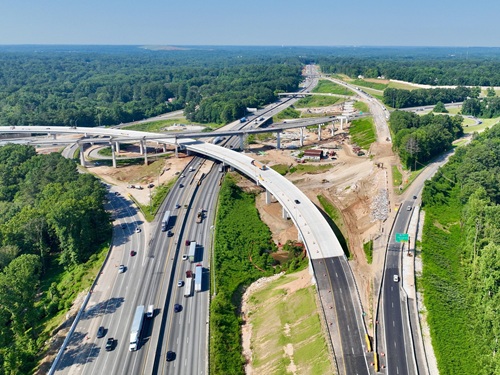A recent hearing held by the Subcommittee on Highways and Transit within the House of Representatives Committee on Transportation and Infrastructure examined the challenges and opportunities affecting implementation of the $1.2 trillion Infrastructure Investment and Jobs Act or IIJA.
[Above image via the House T&I committee]
Enacted in November 2021, the IIJA provided “historic funding increases” for a wide range of U.S. infrastructure needs, noted Rep. Rick Crawford (R-AR), chairman of the highways and transit subcommittee, in his opening remarks at the hearing.

For that reason, he said it is “essential that Congress performs its oversight role to ensure efficient and effective use of taxpayer dollars, and to ensure that the [Biden] administration is implementing IIJA consistent with the letter of the law. Oversight is not a Republican or Democratic issue. Congress must fulfill its duty to ensure IIJA is being implemented as written and that resources are addressing our most pressing transportation infrastructure and supply chain needs.”

Marc Williams, executive director of the Texas Department of Transportation, testified on behalf of the American Association of State Highway and Transportation Officials and the state department of transportation community.
He was one of four witnesses at the hearing from different transportation industry segments providing insight into the IIJA implementation process.
“Our state DOTs are committed to doing our part to achieve successful delivery of the IIJA by improving transportation safety, mobility, and resiliency,” he explained in his remarks. “In Texas, federal funding represents one-third of our overall transportation program, so the IIJA’s five-year duration, its record increase in formula funds to states, and increased program flexibility enable Texas – and our state DOT peers – to address our own unique transportation needs.”

Williams highlighted seven key issues state DOTs are grappling with as they implement the IIJA:
- Safety: “Indisputably, the biggest challenge facing state DOTs is the dramatic increase in roadway traffic fatalities over the past three years,” he said. “Every day, we are faced with the tragic loss of life across this country. [We lose] over 40,000 individuals every year now on our nation’s roadways. In Texas, it has been over 22 years since we experienced a single day without a traffic death. The IIJA’s increased funding and flexibility for the Highway Safety Improvement Program allows states to expand our efforts to identify and implement important countermeasures to reduce fatalities and serious injuries.”
- Inflation: “State DOTs are facing inflation and supply chain challenges that have significantly driven up project costs. In Texas, our highway cost index growth exceeds 30 percent, effectively eroding the gain in federal buying power offered by the IIJA.”
- Contract Authority: “The recently reported $3.5 billion contract authority discrepancy between the Federal Highway Administration and the U.S. Department of Transportation accounting systems is another major concern to state DOTs, as this could negatively impact highway formula dollars which are the most effective means of delivering federal investment nationwide. States ask Congress and USDOT to ensure that any accounting reconciliation will not impact state contract authority.”
- Grant Programs: “While the large number of discretionary grants included in the IIJA presents added funding opportunities, they also create challenges for states, local partners, and even USDOT. The cost of developing one grant application can reach $200,000 for AASHTO members. The vast majority of proposals are unsuccessful, and those few that are successful can take up to 18 months for the grant award to be finalized and funds obligated.”
- New Build America-Buy America Rules: “AASHTO members strongly support the expansion of America’s manufacturing capacity and workforce that are sought through the policy objectives of ‘Build America Buy America’ rules. However, uncertainty and complexities related to implementation of program requirements contribute to project delays and increased costs, with contractors and utility companies struggling to meet the new and evolving sourcing requirements.”
- Electric Vehicle Infrastructure: “AASHTO and state DOTs are working to deliver the goals and outcomes established by Congress via the new National Electric Vehicle Infrastructure formula program. To effectively utilize this funding, flexibility and adaptability in how and where to install EV chargers and in contracting methods will help states meet their unique needs.”
- Workforce Development: “[This] remains a critical issue for AASHTO’s members, as it has contributed to the significant rise in project delivery costs and presents challenges to state DOTs in managing their programs. Like other states, TxDOT is experiencing the highest workforce attrition rate we have seen in decades.”
Paula Hammond – senior vice president for consulting firm WSP USA – highlighted similar issues in her testimony at the hearing on behalf of the American Road & Transportation Builders Association, as well as key funding points as well.

“Nearly half of the IIJA’s generational investment – $450 billion – will be spent improving highways, bridges, and public transportation systems; representing the largest nominal increase in highway funding in 65 years,” explained Hammond, who served as the secretary of the Washington State Department of Transportation during her long career in the infrastructure sector.
“The [IIJA’s] success will be built on the strong partnership between the federal government and states,” she emphasized. “Federal investment supports more than 50 percent of the average state’s capital outlays, with some states relying on federal funds for more than 80 percent.”
Hammond noted that the “foundation” of the federal-state partnership where infrastructure projects are concerned centers on formula funding programs.
“These programs facilitate the pursuit of national needs in a manner that respects state flexibility in project selection,” she said. “The formula programs create state funding certainty, which drives growth in state transportation budgets.”

Dwayne Boyd, president of the Mid-South Region for CRH Americas Materials, echoed those points in his testimony on behalf of the National Stone, Sand & Gravel Association, while emphasizing that “regulatory roadblocks” could hamper IIJA implementation efforts.
“As IIJA is implemented, my company and the entire construction industry find it critical to ensure the funds authorized and appropriated continue to flow as intended for the life of the bill,” he pointed out.
“However, [state DOTs] have reported inflation has eroded the buying power of the increased funding levels, resulting in a smaller number of projects being let,” Boyd said. “That is why it is imperative Congress and the administration work to rapidly implement the provisions under IIJA and remove regulatory roadblocks and red tape that hold us back.”
That’s a particular concern where the new “Build America/Buy America” rules are concerned, he emphasized.
“Unfortunately, even after a year of work to implement the new requirements, the OMB [the Office of Management and Budget] issued a confusing and contradicting rule that revised previous guidance issued,” Boyd noted.
“This new rule introduces new requirements that were not included in the IIJA and places the congressionally mandated exclusion for aggregates-based products, like asphalt and concrete, at risk,” he said. “If OMB proceeds with their rulemaking, it will upend years-long work to get the [new] requirements enacted, likely requiring [state] DOTs and federal agencies to delay projects, further complicating implementation of the IIJA’s funding.”

Aric Dreher, assistant general manager for construction contractor Cianbro, made similar points in his testimony at the hearing on behalf of the Associated Builders and Contractors or ABC – focusing particularly on IIJA workforce provisions and executive orders issued by the Biden administration that conflict with them.
“Since the bill was signed into law in 2021, the administration has taken executive regulatory action, departing from the congressional intent of the bill and showing clear and unnecessary favoritism toward unionized contractors and labor on taxpayer-funded infrastructure projects receiving federal funds,” he said.
“We have also seen significant changes in our economy that I believe will affect the overall success of this bipartisan effort, including record inflation, supply chain delays and workforce shortages,” Dreher added.
“Combined with our current labor shortage and supply chain pressures, it is becoming increasingly difficult for construction projects to continue as originally planned,” he emphasized. “ABC anticipates the construction industry will need to attract half a million additional workers on top of the normal pace of hiring in 2023 to meet the demand for labor – attributing a portion of this demand to a growing number of megaprojects associated with chip manufacturing plants, clean energy facilities and infrastructure, as well as too few younger workers entering the skilled trades.”
Dreher emphasized that “after-the-fact regulations and strings” attached to federal infrastructure grant programs will severely impact the allocation of IIJA funds.
They will “restrict competition for taxpayer-funded construction projects to union contractors and workers at the expense of fair and open competition that provides opportunities for all qualified workers while offering the best value for taxpayers,” he said.
 Top Stories
Top Stories
How Rising Construction Costs Could Impact Reauthorization
November 14, 2025 Top Stories
Top Stories

